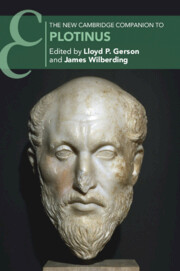Book contents
- The New Cambridge Companion to Plotinus
- Other Volumes in the Series of Cambridge Companions
- The New Cambridge Companion to Plotinus
- Copyright page
- Contents
- Figures
- Tables
- Contributors
- Acknowledgements
- Porphyry’s Arrangement of the Enneads
- Abbreviations of Other Ancient Works and Authors
- Introduction
- Part I Historical Context
- Part II Metaphysics and Epistemology
- Part III Psychology
- Part IV Natural Philosophy
- 11 Eternity and Time
- 12 Composition of Sensible Bodies
- 13 Nature: Plotinus’ Fourth Hypostasis?
- Part V Ethics
- Bibliography
- Index Locorum
- Index
- Other Volumes in the Series of Cambridge Companions (continued from page ii)
12 - Composition of Sensible Bodies
from Part IV - Natural Philosophy
Published online by Cambridge University Press: 25 May 2022
- The New Cambridge Companion to Plotinus
- Other Volumes in the Series of Cambridge Companions
- The New Cambridge Companion to Plotinus
- Copyright page
- Contents
- Figures
- Tables
- Contributors
- Acknowledgements
- Porphyry’s Arrangement of the Enneads
- Abbreviations of Other Ancient Works and Authors
- Introduction
- Part I Historical Context
- Part II Metaphysics and Epistemology
- Part III Psychology
- Part IV Natural Philosophy
- 11 Eternity and Time
- 12 Composition of Sensible Bodies
- 13 Nature: Plotinus’ Fourth Hypostasis?
- Part V Ethics
- Bibliography
- Index Locorum
- Index
- Other Volumes in the Series of Cambridge Companions (continued from page ii)
Summary
Plotinus places emphasis on the intelligible world since it is the paradigm of truth, beauty, and being. Porphyry even orders the treatises in a way that mirrors the ascent to the intelligible world and beyond to the One. This has created the impression for generations that Plotinus is uninterested in the natural world. This is an oversimplification. Plotinus has a sophisticated natural philosophy but it can be difficult to piece together into a coherent whole because much of his comments occur in polemical contexts where he is arguing against a rival school, and they are spread throughout numerous, seemingly unrelated treatises. This is especially the case for his doctrine on sensible bodies. The departure for Plotinus’ view is Timaeus 49d–50a, where Timaeus claims that only the receptacle can be called a ‘this’ (tode) or a ‘that’ (touto), but a thing that enters and leaves the receptacle, such as a primary body, is a ‘what is such’ (toiouton). Plotinus, however, develops Plato’s view by critically engaging with Aristotle and the Peripatetic tradition and reinterpreting the Platonic view in the scheme of his hierarchical metaphysics.
- Type
- Chapter
- Information
- The New Cambridge Companion to Plotinus , pp. 289 - 311Publisher: Cambridge University PressPrint publication year: 2022
- 1
- Cited by



